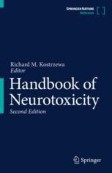Search
Search Results
-
Characterization of Gut Microbiota in Rats and Rhesus Monkeys After Methamphetamine Self-administration
Methamphetamine (MA) is one of the most abused drugs globally, but the mechanism of its addiction remains unclear. Several animal studies have shown...

-
Effect of the glucagon-like peptide-1 (GLP-1) receptor agonist semaglutide on alcohol consumption in alcohol-preferring male vervet monkeys
RationaleGlucagon-like peptide-1 (GLP-1) receptor agonists reduce alcohol consumption in rodents and non-human primates. Semaglutide is a new...

-
The neuropharmacological profile of interval responding during operant tasks
Responses occurring during intervals of operant tasks have been subdivided as interim, facultative, and terminal, depending on the time between...
-
Choice between food and cocaine or fentanyl reinforcers under fixed and variable schedules in female and male rhesus monkeys
RationaleIllicit drugs may be unpredictable in terms of the time and effort required to obtain them, and this can be modeled with variable- (VR) vs....

-
Enhanced Beta2-band Oscillations Denote Auditory Hallucination in Schizophrenia Patients and a Monkey Model of Psychosis
An electroencephalographic (EEG) signature of auditory hallucinations (AHs) is important for facilitating the diagnosis and treatment of AHs in...

-
Theory of visual attention (TVA) applied to rats performing the 5-choice serial reaction time task: differential effects of dopaminergic and noradrenergic manipulations
RationaleAttention is compromised in many psychiatric disorders, including attention-deficit/hyperactivity disorder (ADHD). While dopamine and...

-
Neurochemistry of the mammillary body
The mammillary body (MB) is a component of the extended hippocampal system and many studies have shown that its functions are vital for mnemonic...
-
Stimulus mediation, specificity and impact of menthol in rats trained to discriminate puffs of nicotine e-cigarette aerosol from nicotine-free aerosol
RationaleIt is unclear if e-cigarettes have reduced abuse liability relative to traditional cigarettes, especially when considering advanced devices...

-
The Use of Touchscreen-Based Methods to Characterize Effects of Psychoactive Drugs on Executive Function in Nonhuman Primates
Purpose of ReviewThis review describes studies that assessed the acute and chronic effects of commonly consumed drugs on executive function, with a...

-
Finding an Optimal Level of GDNF Overexpression: Insights from Dopamine Cycling
The application of glial cell line-derive neurotrophic factor (GDNF) to cell cultures and animal models has demonstrated positive effects upon...

-
Neurotrophic Factors in Parkinson’s Disease: Clinical Trials
Introduction: Parkinson’s disease (PD)Parkinson’s disease is characterized by the progressive loss of midbrain dopamine (DA) neurons that regulate...
-
Effects of Chronic Ephedrine Toxicity on Functional Connections, Cell Apoptosis, and CREB-Related Proteins in the Prefrontal Cortex of Rhesus Monkeys
Ephedrine abuse has spread in many parts of the world, severely threatening human health. The mechanism of ephedrine toxicity is still unclear. To...

-
Self-administration of the synthetic cathinones 3,4-methylenedioxypyrovalerone (MDPV) and α-pyrrolidinopentiophenone (α-PVP) in rhesus monkeys
RationaleThe availability and abuse of synthetic analogues of cathinone have increased dramatically around the world. Synthetic cathinones, such as...

-
Neurochemical Anatomy of Cushing’s Syndrome
The neurochemical anatomy underlying Cushing’s syndrome is examined for regional brain metabolism as well as neurotransmitter levels and receptor...

-
Neurotoxicity in Psychostimulant and Opiate Addiction
Psychostimulants and opioids evoke toxicity within the central nervous system (CNS), primarily linked to action of the substance (e.g., enhancement...
-
Neurotoxicity in Psychostimulant and Opiate Addiction
Psychostimulants and opioids evoke toxicity within the central nervous system (CNS), primarily linked to action of the substance (e.g., enhancement...
-
The protein kinase Cβ-selective inhibitor, enzastaurin, attenuates amphetamine-stimulated locomotor activity and self-administration behaviors in rats
RationalePathological amphetamine (AMPH) use is a serious public health concern with no pharmacological treatment options. Protein kinase Cβ (PKCβ)...

-
Behavioural effects of APH199, a selective dopamine D4 receptor agonist, in animal models
RationaleThe dopamine D4 receptors (DRD4) play a key role in numerous brain functions and are involved in the pathogenesis of various psychiatric...

-
The Evolving Role of Animal Models in the Discovery and Development of Novel Treatments for Psychiatric Disorders
Historically, animal models have been routinely used in the characterization of novel chemical entities (NCEs) for various psychiatric disorders....
-
D3 Receptors and PET Imaging
This chapter encapsulates a short introduction to positron emission tomography (PET) imaging and the information gained by using this technology to...
